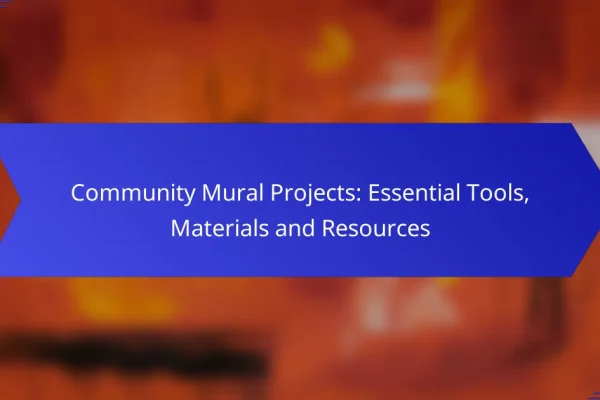How to plan a community mural project in urban areas?
Planning a community mural project in urban areas involves defining clear objectives, engaging local stakeholders, and navigating regulatory requirements. Successful projects enhance community identity and foster collaboration among residents.
Define project goals
Establishing project goals is crucial for guiding the mural’s theme, style, and community impact. Consider whether the aim is to beautify a neighborhood, address social issues, or celebrate local culture. Clear objectives help align the community’s vision and expectations.
For example, a project might focus on promoting environmental awareness or honoring local history. Setting measurable goals can also assist in evaluating the project’s success post-completion.
Engage local stakeholders
Involving local stakeholders, including residents, businesses, and community organizations, is key to a successful mural project. Host meetings or workshops to gather input and foster a sense of ownership among participants. This engagement can lead to a mural that truly reflects the community’s values.
Consider forming a project committee that includes diverse voices. This approach not only builds support but can also enhance the mural’s design and relevance.
Identify suitable locations
Choosing the right location for a mural is essential for visibility and community engagement. Look for high-traffic areas that are accessible and resonate with the community’s identity. Walls of community centers, schools, or local businesses are often ideal spots.
Conduct a site assessment to evaluate the wall’s condition, size, and surrounding environment. Ensure the location aligns with the project’s goals and is approved by local stakeholders.
Secure necessary permits
Before starting the mural, it is important to secure the necessary permits from local authorities. Regulations can vary significantly by city, so check with your local government or arts commission for specific requirements.
Common permits may include public art permits or zoning approvals. Allow ample time for this process, as it can take weeks or even months to finalize approvals.
Budgeting and funding options
Creating a budget for a community mural project involves estimating costs for materials, labor, and permits. Typical expenses can range from a few hundred to several thousand dollars, depending on the mural’s size and complexity.
Explore funding options such as local grants, crowdfunding, or sponsorship from businesses. Engaging the community in fundraising efforts can also enhance ownership and support for the project.
What materials are needed for community mural projects?
Community mural projects require a variety of materials to ensure successful execution and longevity. Key items include paint, brushes, tools for application, and protective coatings to preserve the artwork.
Types of paint and supplies
For murals, high-quality exterior acrylic paints are often preferred due to their durability and vibrant colors. These paints can withstand weather conditions and UV exposure, making them ideal for outdoor projects.
Additional supplies may include paint rollers, spray paints, and paint markers for detailed work. It’s essential to choose non-toxic options, especially in areas frequented by children or pets.
Tools for mural application
Essential tools for mural application include brushes of various sizes, rollers, and spray guns. Each tool serves a different purpose; for instance, large rollers cover vast areas quickly, while fine brushes allow for detailed work.
Consider using scaffolding or ladders for higher sections of the mural to ensure safety and ease of access. Always check local regulations regarding the use of ladders or scaffolding in public spaces.
Protective coatings and finishes
After completing a mural, applying a protective coating is crucial for its longevity. Clear acrylic sealants or varnishes can help shield the mural from weather damage and fading.
When selecting a protective finish, look for options that are UV-resistant and suitable for outdoor use. Regular maintenance, such as reapplying the coating every few years, can greatly extend the life of the mural.
How to involve the community in mural creation?
Involving the community in mural creation fosters ownership and pride in the project. Engaging local residents ensures that the mural reflects their values and stories, making it a true representation of the community.
Organize workshops and brainstorming sessions
Workshops and brainstorming sessions are effective ways to gather ideas and input from community members. These gatherings can be structured to encourage creativity, allowing participants to share their visions for the mural.
Consider hosting multiple sessions to accommodate different schedules and demographics. Providing materials like sketch paper and markers can help participants visualize their ideas and contribute more effectively.
Collaborate with local artists
Partnering with local artists brings professional expertise and artistic vision to the mural project. These artists can guide community members in refining their ideas and translating them into a cohesive design.
Look for artists who have experience with community projects and understand the local culture. This collaboration can also enhance community engagement, as residents may feel more connected to the mural when they see familiar faces involved.
Gather community feedback on designs
Once initial designs are created, it’s crucial to gather feedback from the community. This can be done through surveys, public meetings, or social media platforms, allowing residents to voice their opinions and suggestions.
Incorporating feedback not only improves the design but also strengthens community buy-in. Be transparent about how feedback will be used and consider holding follow-up sessions to discuss revisions and finalize the design before painting begins.
What are the best practices for mural maintenance?
The best practices for mural maintenance include regular cleaning, community involvement, and effective weatherproofing techniques. These strategies help preserve the mural’s appearance and longevity while fostering a sense of ownership among local residents.
Regular cleaning and touch-ups
Regular cleaning is essential to maintain the vibrancy of a mural. Use gentle soap and water to remove dirt and grime, ideally every few months, depending on the mural’s location and exposure to the elements. Touch-ups should be performed as needed, using the same paint type and colors to ensure consistency.
Consider scheduling cleaning sessions as community events to engage local residents. This not only helps maintain the mural but also strengthens community ties and awareness of the artwork.
Community involvement in upkeep
Encouraging community involvement in mural upkeep can significantly enhance its preservation. Organize volunteer days where residents can participate in cleaning, touch-ups, or even planning future maintenance. This fosters a sense of pride and responsibility towards the mural.
Creating a stewardship group can help maintain ongoing interest and commitment. This group can coordinate efforts, share responsibilities, and ensure that the mural is cared for over time.
Weatherproofing techniques
Weatherproofing is crucial for protecting murals from the elements. Applying a clear sealant can help shield the artwork from moisture, UV rays, and pollutants. Choose a sealant that is compatible with the mural’s paint and suitable for the local climate.
Regularly inspect the mural for signs of wear due to weather exposure, such as fading or peeling. Addressing these issues promptly can prevent more extensive damage and prolong the mural’s life.
How to measure the impact of community murals?
Measuring the impact of community murals involves assessing both qualitative and quantitative factors. Key metrics include community engagement, economic effects, and social cohesion, which can be evaluated through surveys, interviews, and local economic data.
Community engagement metrics
Community engagement metrics focus on how well the mural resonates with local residents. This can be measured through attendance at mural unveiling events, participation in workshops, or social media interactions. Gathering feedback via surveys can provide insights into community sentiment and involvement.
Economic impact assessment
To assess the economic impact of community murals, consider factors such as increased foot traffic, local business revenue, and tourism. Analyzing sales data from nearby businesses before and after mural installation can reveal changes in economic activity. Additionally, tracking visitor numbers can help quantify the mural’s draw.
Social cohesion evaluation
Social cohesion can be evaluated by examining changes in community relationships and interactions following mural completion. Conducting interviews or focus groups can uncover shifts in community pride and identity. Observing public gatherings or events in the mural’s vicinity can also indicate enhanced social connections.












